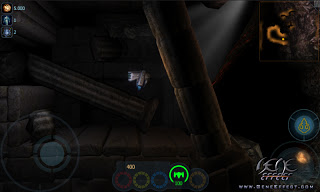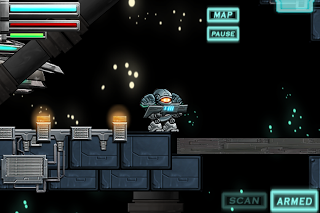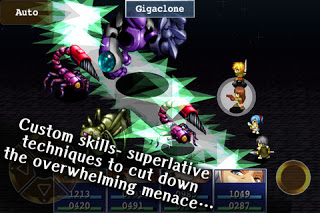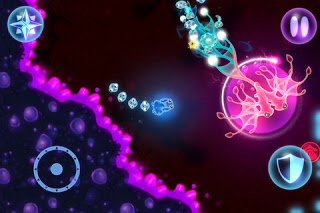Yesterday [Bulkypix & Pendulo] – $4.99
Number of Results: 8
Each Mission has certain objectives which you’ll need to achieve either before progressing to the next area of a level, or completing the stage. These range from collecting DNA samples, to finding different resources like Koronite (the main orange material which you’ll be collecting a ton of), and taking it to certain drop off areas within the levels, or collecting red, blue, and yellow crystal energy to start up reactors, as well as searching for sensors to unlock doors, and more.
 Lightstorm3D has definitely shown that they know exactly what it takes to make an amazingly immersive, incredibly depthy game with Gene Effect. The story, gameplay, graphics, controls, music, everything about the game really stands out as top-notch. Even without having GameCenter integration with no online achievements, or leader boards, it has a great amount of replay value that will drive completionists batty. Fans of exploration, sci-fi, mining, action, adventure and even puzzle games would do well to get this on their device as soon as possible. Gene Effect is definitely a game that stands out as a true console-like experience in an AppStore full of casual pick-up-and-play flash games. The $5 price of admission is well worth the journey you’ll be privileged to experience, and is highly recommended to all gamers looking for something more from the games on their iDevice. I sincerely hope iOS gamers will be able to see more from Lightstorm3D. It’s games like this that give me hope that the iDevice will grow into a serious gaming platform in the near future.
Lightstorm3D has definitely shown that they know exactly what it takes to make an amazingly immersive, incredibly depthy game with Gene Effect. The story, gameplay, graphics, controls, music, everything about the game really stands out as top-notch. Even without having GameCenter integration with no online achievements, or leader boards, it has a great amount of replay value that will drive completionists batty. Fans of exploration, sci-fi, mining, action, adventure and even puzzle games would do well to get this on their device as soon as possible. Gene Effect is definitely a game that stands out as a true console-like experience in an AppStore full of casual pick-up-and-play flash games. The $5 price of admission is well worth the journey you’ll be privileged to experience, and is highly recommended to all gamers looking for something more from the games on their iDevice. I sincerely hope iOS gamers will be able to see more from Lightstorm3D. It’s games like this that give me hope that the iDevice will grow into a serious gaming platform in the near future.

![]() With Action RPG’s pretty much dominating the Role Playing charts in iTunes for the last couple years, it’s pretty sad seeing most of them going down the drain. There’s just not much more you can do to make an original Action RPG these days. Thankfully, Turn-Based RPGs are making a huge comeback, with help from two big companies, Square Enix, and Kemco, and the latest addition to the old-school influenced turn-based RPG genre, is Kemco’s Eve of the Genesis.
With Action RPG’s pretty much dominating the Role Playing charts in iTunes for the last couple years, it’s pretty sad seeing most of them going down the drain. There’s just not much more you can do to make an original Action RPG these days. Thankfully, Turn-Based RPGs are making a huge comeback, with help from two big companies, Square Enix, and Kemco, and the latest addition to the old-school influenced turn-based RPG genre, is Kemco’s Eve of the Genesis.
 Now, if you’re familiar with Kemco’s previous iOS releases, Eve of the Genesis is sort of a mixture of Alphadia and Symphony of Eternity. Fantastic story-telling, as well as top-notch translation, completely draws you into the plot, and makes you actually feel, and care for, the characters. The story takes place in the Empire of Gadalia. It’s kind of a matrix type story, with humans battling machines that ruled the empire, but were defeated 2,000 years ago. Now they’re back, and somehow able to travel through space, seemingly appearing anywhere they want to attack. Your characters are on a quest to try and find out how the machines are able to just appear anywhere they want, and eventually find a way to stop them from taking over the empire yet again.
Now, if you’re familiar with Kemco’s previous iOS releases, Eve of the Genesis is sort of a mixture of Alphadia and Symphony of Eternity. Fantastic story-telling, as well as top-notch translation, completely draws you into the plot, and makes you actually feel, and care for, the characters. The story takes place in the Empire of Gadalia. It’s kind of a matrix type story, with humans battling machines that ruled the empire, but were defeated 2,000 years ago. Now they’re back, and somehow able to travel through space, seemingly appearing anywhere they want to attack. Your characters are on a quest to try and find out how the machines are able to just appear anywhere they want, and eventually find a way to stop them from taking over the empire yet again.  Right now, Eve of the Genesis is having a launching sale of 67% off, reducing the price from $8.99 to $2.99, but with how amazingly well done Kemco’s turn-based RPGs are, $8.99 is a great deal for this game. Yet again, it brings back memories of playing old-school Final Fantasy titles on the Nintendo, and SNES. The very well written story, as well as the fantastic graphics, great animations, and deep gem/orb system, makes for an adventure game that will totally immerse you, making it hard for you to focus on anything else until you complete it. Kemco has done it again, with another flawless release, and after visiting their website, you’ll hope that their other titles, like End of Aspiration, Machine Knight, Kamen Rider Fourze, and more will all be ported to the iOS.
Right now, Eve of the Genesis is having a launching sale of 67% off, reducing the price from $8.99 to $2.99, but with how amazingly well done Kemco’s turn-based RPGs are, $8.99 is a great deal for this game. Yet again, it brings back memories of playing old-school Final Fantasy titles on the Nintendo, and SNES. The very well written story, as well as the fantastic graphics, great animations, and deep gem/orb system, makes for an adventure game that will totally immerse you, making it hard for you to focus on anything else until you complete it. Kemco has done it again, with another flawless release, and after visiting their website, you’ll hope that their other titles, like End of Aspiration, Machine Knight, Kamen Rider Fourze, and more will all be ported to the iOS.
![]() Exploritory Metroidvania-type games are a pretty big rarity in the AppStore, but those that can be found are extremely well made. Glowfish, by MumboJumbo (Luxor, 7 Wonders), is no exception to this. You’ll guide Glowfish through 50+ levels, finding all the little glowing fish you can use as your shield, defeating interesting enemies, exploring the depths for hidden areas, collecting coins, and gaining friends that you can take along with you, lending their abilities.
Exploritory Metroidvania-type games are a pretty big rarity in the AppStore, but those that can be found are extremely well made. Glowfish, by MumboJumbo (Luxor, 7 Wonders), is no exception to this. You’ll guide Glowfish through 50+ levels, finding all the little glowing fish you can use as your shield, defeating interesting enemies, exploring the depths for hidden areas, collecting coins, and gaining friends that you can take along with you, lending their abilities.
 You’ll control your Glowfish with a virtual joystick, a shield button, which either brings the fish you’ve collected into a shield circle around you, or lets them trail behind you, letting you access areas joined by a small pathway, along with tapping on the screen to dash in the direction you are facing.
You’ll control your Glowfish with a virtual joystick, a shield button, which either brings the fish you’ve collected into a shield circle around you, or lets them trail behind you, letting you access areas joined by a small pathway, along with tapping on the screen to dash in the direction you are facing. Glowfish is $2.99 for the iPhone, and $4.99 for the iPad, and worth every single penny, and then some. It is supported by GameCenter with a highscore leader board and 25 achievements, which, combined with the 4 star ratings available on each level, adds to the replay value a bit, though you probably won’t play through Glowfish more than one time in a row, it is a game that will call you back after a month or two. It certainly is a game that everyone who owns an iDevice should check out, and will easily end up on quite a few top games of 2011 lists.
Glowfish is $2.99 for the iPhone, and $4.99 for the iPad, and worth every single penny, and then some. It is supported by GameCenter with a highscore leader board and 25 achievements, which, combined with the 4 star ratings available on each level, adds to the replay value a bit, though you probably won’t play through Glowfish more than one time in a row, it is a game that will call you back after a month or two. It certainly is a game that everyone who owns an iDevice should check out, and will easily end up on quite a few top games of 2011 lists.